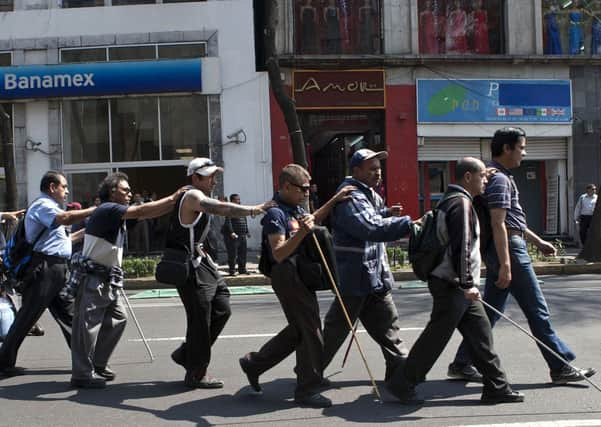Protests at Mexico City Metro crackdown


They hawked their wares with painfully loudspeakers carried on their backs, sometimes alongside bizarre “street” performances – shirtless, homeless men being walked on as they lay on a bed of broken glass; off-key singers so bad they ought to have been paid to stop. It wasn’t just a subway ride: it was an adventure.
But now those behind the subway that ranks among the world’s ten largest, carrying more than 1.6 billion passengers a year, are cracking down on the sideshow that was the Metro.
Advertisement
Hide AdAdvertisement
Hide AdThe Collective Transportation System started telling vendors they were not welcome on the carriages in December. Yesterday, vendors were officially banned on all 12 lines and from all 162 stations.
Passenger Jaime Lemus said: “It’s the way it’s supposed to be. It was horrible, people coming in and bothering people.”
In response, thousands of informal vendors – no-one has an exact count – have taken their loudspeakers to the streets and to city hall, marching to complain the local government is removing their livelihood without providing an alternative.
The city has offered them 2,098-peso (£95) monthly stipends, requiring that they take employment retraining classes in a variety fields, from hotel work to massage therapy.
Vendors, some of whom made more than three times as much on the Metro, say it’s not a real offer. Most are not interested in changing careers.
While more than 2,000 have registered to receive the stipends, only 967 have enrolled in classes, according to the city.
Those kicked off the Metro have also been offered alternative spots to sell legally.
Juan Jose Hernandez Diaz, who has been selling on the Metro for 25 years, said: “They’re offering us locations where there are no people; places other merchants have abandoned because there are no people.
Advertisement
Hide AdAdvertisement
Hide Ad“We can’t live on 500 pesos a week. I have a daughter in high school. Her expenses are 100 pesos a day.”
Officially, vendors have always been banned from selling in the subway. But in a quintessential combination that makes Mexico City, people who need jobs create their own, and authorities unevenly enforce the laws. It boils down to an economic struggle.
Because the majority of Mexicans work in the informal economy, cleaning up public areas inevitably puts some out of work.
But authorities insist selling on the subway is inappropriate. “The Metro is a means of transport, not a place for selling,” one transit official said.
He pointed to recent polls for the transit authority, in which passengers listed the vendors as one of their top three annoyances in using the system.
The polls were taken at the time of a controversial fare rise in December. Officials promised the additional money would provide more trains, faster service and better security, including kicking out the vendors.
The city has added hundreds of new auxiliary police to patrol the platforms and carriages. Vendors caught selling have their wares confiscated and face short-term detention in what the city uses as a drunk tank.
Vendor Rodolfo Aguilera says he wants the government to pool the money it would give in stipends to create permanent stands near platforms. The city counters that vendors need classes to run the stands. So far, there is no way out of the stalemate.
Advertisement
Hide AdAdvertisement
Hide AdThe vendors continue selling quietly, walking through every carriage. But they hide their wares in bags and don’t begin calling out until the doors shut, so they aren’t detected by police.
And even the vendors acknowledged their loudspeakers were really annoying.